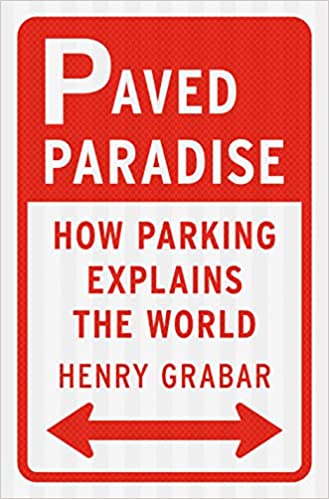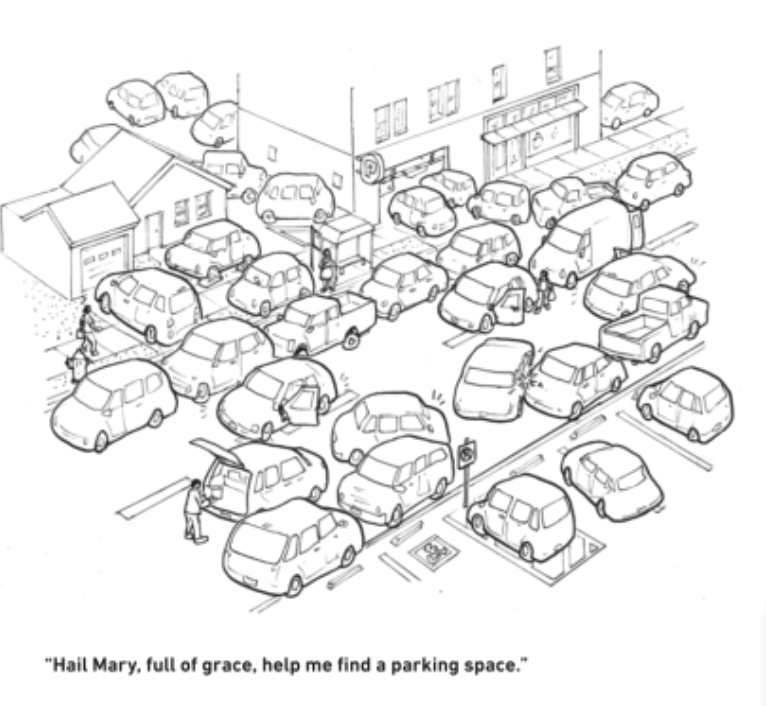The first time I personally encountered Donald Shoup, in 2009, I interviewed him for an article I was writing on parking reform. I offhandedly mentioned that I had read The High Cost of Free Parking. With his characteristic combination of charm and incredulity, he demanded, "You read the whole thing?!"
I admitted that "skimmed" was more like it.
Even Don Shoup knows that 800 pages of economic analysis of free, paid, and under-priced parking can put anyone into a coma, even if it started a revolution.
Such is not the case with Paved Paradise: How Parking Explains the World--the best, and breeziest, book on parking since Shoup Dogg first dropped the mic. By journalist Henry Grabar, who is best known for writing about cities on Slate, Paved Paradise is hip, current, and comprehensive. It covers not just Shoupian economics but also design, business, public administration, culture, and just about every other impact that parking has on America's cities, soul, and psyche in a relatively slim 300 pages.
For Grabar, "parking is the primary determinant of the way the place you live looks, feels, and functions."
 The value of Grabar's project lies partly in the aggregation. In one volume, he illustrates just how massive the problem is. He reports that most cities have more parking spaces--public and private--than people: 12 million spaces in Phoenix, 2.2 million in Philadelphia, and 18.6 million in Los Angeles County (covering 200 square miles). It costs an average of $4,400 annually to park each car in the United States and, by another measure, a total between $189 billion and $554 billion, "with drivers paying just $5 billion per year" and the rest baked into the cost of goods, services, real estate, and public services. New York City has between 1.3 million and 3 million street spaces alone; the precise number is unknown. In part because people usually have only one home whereas cars need to park wherever they go, "by square footage, there is more housing for each car in United States than there is housing for each person"
The value of Grabar's project lies partly in the aggregation. In one volume, he illustrates just how massive the problem is. He reports that most cities have more parking spaces--public and private--than people: 12 million spaces in Phoenix, 2.2 million in Philadelphia, and 18.6 million in Los Angeles County (covering 200 square miles). It costs an average of $4,400 annually to park each car in the United States and, by another measure, a total between $189 billion and $554 billion, "with drivers paying just $5 billion per year" and the rest baked into the cost of goods, services, real estate, and public services. New York City has between 1.3 million and 3 million street spaces alone; the precise number is unknown. In part because people usually have only one home whereas cars need to park wherever they go, "by square footage, there is more housing for each car in United States than there is housing for each person"
Through a minor miracle of storytelling, Grabar takes a topic that is literally static and gives it intrigue through numerous anecdotes (plus delightful illustrations by Oakland-based artist and urbanist Alfred Twu). He recounts the sordid tale of the privatization (and pillaging) of Chicago's parking meters. He goes on a metaphorical ride-along with New York's most hard-nosed parking attendant. He reveals how low-level employees have scammed airports out of potentially millions of dollars in revenue. He sympathizes with developers who, through regulations and lenders' mandates, have to build and then gaze upon dozens or even hundreds of empty spaces. He eavesdrops on stakeholders demanding that proposed projects be downsized lest they have inadequate parking. He sympathizes with small businesses saddled with more asphalt than inventory.
Paved Paradise also covers the vicious policy cycles that led to the parking regulations (i.e. minimums) that prevail across the United States. After World War II, civic leaders in almost every city in the country decided that downtowns needed ample parking to appeal to a newly mobile population (at least among wealthy, white Americans). And so, they built so much parking -- and demolished so many attractive, functional buildings -- that downtowns lost their appeal entirely. The same principle applies to parking requirements on individual lots, especially for commercial establishments. Often with more parking than structure, standalone stores and restaurants all look like Taco Bells.
Poignantly invoking Ashton Kutcher, Grabar asks, "Dude, where's my town?"
Across the country, mid-size developments (commercial and residential alike) fall into the Valley of High Parking Requirements: "Anything between sprawl and high density development was impossible to build because it was impossible to park – surface parking will take up too much room; structured parking will cost too much to build."
"Mostly, America just stopped building small buildings," Grabar writes. "Parking requirements help trigger an extinction-level event for bite-sized, infill apartment buildings like rowhouses, brownstones, and triple-deckers; the production of buildings with two to four units fell more than 90% between 1971 and 2021."

Oakland-based artist Alfred Twu.
It would be one thing if requirements were rational. But, as Shoup ably demonstrates, parking standards are, at best, exaggerations of actual needs and, at worst, totally arbitrary. For instance, Grabar tells us that--for no apparent reason--high schools in Mesa, Arizona, require five times as much parking as those in Kansas City do. Omaha requires twice as much office parking per square foot as Denver does. In many cases, parking requirements, whatever they may be, end up being bargaining chips for opponents of development rather than anything resembling tools of rational transportation planning.
Geographic bias aside, Grabar's strongest chapter is on Los Angeles. It is there that he fully explains the hideous toll parking has taken on architecture and urban design, where strip malls and enormous garages illustrate the unofficial architectural maxim that "form follows parking." He notes that Los Angeles's popular six- and eight-unit "dingbat" style became untenable when the city started requiring 1.5 parking spaces per two-bedroom apartment in 1964, and space that used to be dedicated to courtyards now now goes to parking. And he notes parking's role in gentrification. "Parking requirements… make the attractive, desirable, and now high-priced neighborhoods of the early 20th century illegal," he writes, mentioning Los Angeles’s Silver Lake and Highland Park. Because those neighborhoods are rare, and dear, "one of the ironies that has emerged in recent years is that central, walkable neighborhoods have come in vogue among rich people who own more cars."
(It is also in the Los Angeles chapter that Grabar recounts the crusade of CP&DR Publisher Bill Fulton, who took Shoup's then-obscure class on parking at UCLA in the 1980s, to reprice and revamp the parking scheme for downtown Ventura when he was mayor in the aughts.)
Grabar approaches his subject as much with an eye toward sociology as transportation planning. One of his closing chapters concerns accessory dwelling units and other ways that the often useless garages attached to single-unit homes are repurposed, formally and informally. And he celebrates parklets, National Parking Day, and attempts to dynamically price and regulate curb space for everyone from ice cream trucks (a surprisingly vicious business) to delivery vans to rideshare drivers.
God bless the Shoupistas, but they are a nerdy, avant garde bunch. Every planner working today has firsthand experience with some of these issues, and they're aware of the rest secondhand. They don't necessarily need to read Grabar. But, if planners are to truly reform parking in the United States, they need to tell stories just like Grabar does, making the ills of over-parking and under-pricing accessible to everyone. They need to wrest control away from engineers and NIMBYs and give it to people who want cities to serve humans rather than cars.
Looking to a parking-lite future, Grabar gives shoutouts to California legislation (presumably AB 2097 of 2022), which abolishes parking requirements in certain high-density areas, and notes citywide parking reforms in Indianapolis, New York City, Sacramento, and San Diego. Unfortunately, he doesn't say much about their efficacy. That's reasonable, to the extent that most of these regulations are new. Even so, with so many pages dedicated to the problem of parking, he could have gone deeper into solutions.
Paved Paradise leaves little else to quibble with, leaving few tires unchalked, as it were. Grabar's only major misstep is right there on the cover. Joni Mitchell's environmentalist anthem "Big Yellow Taxi" is over 50 years old and cited in urban literature ad nauseam.
We may not need 800 pages. But, we're also way past tepid folk songs.
Paved Paradise: How Parking Explains the World
By Harry Grabar
Penguin Press
May 9, 2023
368 pages
Hardcover $30.00

